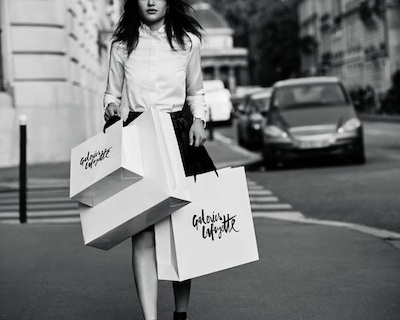As mobile’s eclipse of desktop intensifies, some brands remain stuck behind the curve, according to an L2 report.
While some brands are privy to today’s rapid changes and are implementing innovative marketing strategies, others stay the course with outmoded practices. The continuing decline of desktop is recalibrating consumer demands just as brands were catching up, meaning it is time once again for brands to pivot and win over the impatient consumer.
"[One of the keys is] improving the mobile check out process by reducing friction and making it as easy to check out as possible," said Evan Neufeld, Director of Intelligence at L2. "This typically requires a redesign of the check out process for mobile, vs. just porting the existing process from desktop as many do.
It's important to ensure the process is relatively consistent across mobile sites and apps if the brand in question has both," he said. "Offering features such as expedited payment options (such as PayPal) and single-page checkout are great examples of tactical feature decisions that produce the type of frictionless process we are talking about here.
"For brands that have cross platform (smartphone to desktop to offline) sales, initiating the check out process via email sign-in is key to being able to track consumer consideration and purchase across various devices."
The L2 Intelligence Report: Mobile 2016 examines 68 brands across four categories on mobile, analyzing best practices to help brands achieve greater ROIs.
Behind the curve
In 2015, two-thirds of time spent on digital media was mobile, with applications alone accounting for half. Consumers’ mobile devices are also staples of the in-store shopping experience.
With beacons and digital wallets not reliably integrated into bricks-and-mortar stores, consumers are bringing their own technology into the environment. Price and product comparisons take place on the consumers’ phone, enervating the shopping experience and driving consumers elsewhere.

Barneys' new Chelsea store has implemented beacon technology
A separate report released by DMI earlier this month discovered that 33 percent of shoppers regularly use a mobile device while shopping in a store. Additionally, the lion’s share of these shoppers would visit a store more often and buy more if leading in-store mobile shopping tools were available (see story).
As more becomes available at the fingertips and retail democratizes, consumers are losing patience. Per L2, only 15 percent of shoppers say they will give a brand a second chance after a poor user experience.
These trends will only continue in the future. Mobile commerce growth is outpacing desktop ecommerce and bricks-and-mortar sales by significant rates. In 2015, mobile commerce jumped by nearly a third compared to the prior year.
While the rapid growth indicates the way of the future, it is far from too late for brands to adapt: last year, mobile accounted for a mere 2 percent of overall retail sales.

Galeries Lafayette shopper
Despite the clear signs, few brands have eased the mobile purchase path. Single-page checkouts are rare: retail brands require an average of 12.9 fields to be filled, beauty brands require 14.3 and fashion brands require 16.3.
Some brands have turned to PayPal to smooth checkout, but the custom fields still elongate the process.
Apple Pay has recently been adopted by Lane Crawford in China (see story), and Burberry and Cole Haan – the latter of which is highlighted for its check out process – are among its supporters elsewhere, but luxury retailers lag behind fast-fashion in this intuitive and effective upgrade.
Room to improve
Advertisers have been keen to ramp up ad spend on mobile, showcasing knowledge of the trend. Nevertheless, some of the channels most ripe for driving mobile sales are underutilized.
For example, luxury brands are not taking advantage of WeChat’s direct marketing capabilities, according to another L2 report.
Brands in the fashion and watches and jewelry categories receive an average of 7,000 views per WeChat post, a pittance against the 700 million monthly users. Rather than using WeChat in ways similar to Instagram, Facebook and Twitter, brands should take advantage of its one-to-one communication interface for CRM purposes, to encourage loyalty or drive online-to-offline activity (see story).
In general, retail technology and consumer behavior are not yet in sync.
Retailers are currently in the investment and adoption phase of the future of retail, a plateau on which practices and consumer behavior have yet to catch up with technology, according to a report by Walker Sands.
Walker Sands’ third annual “Future of Retail 2016” study analyzes emerging retail technologies, placing an emphasis on consumer reaction to these potential game-changers and how the adoption of such strategies will affect spending habits. As to be expected, the technology leading retail’s evolution is ecommerce, with nearly a third of surveyed consumers shopping online at least once a week, a jump of 41 percent from 2014 (see story).
{"ct":"BAx3W\/veDaw9O7F1WHbftGA6HrmoSMhM3wdWmmLRMNNgBPgCC9sOC6ZnRkmAq+3U76NCJxUXKin93FQfcFu1THEaSKgXKAnqjsSJMpuPLoe2FGblNnqEOFFJo8qMfv3qmYXSjB3ryvoOCj\/DRutJxCd\/1NJn13+IfhiTXG+LACE\/xJ+wboBO9\/JQjWCrTx8IYf5SFeGbJNk7Ctdd4eyWyPJRK8vXgqnIcG7mGG5KrJmZxWZhqn9FqBloanotIdzZGwaQZqNzcwszN1\/15FPLX2nUaYm1ODmVA5p6Gc0xlzawgMsFWU38\/BzpTUp\/LY2s8ibEX9COlRVLMU0Obz62IOEFgAYhHdHSYuazWvDbz\/7qtIhNg+ZsRCdEIlVXFzIXnwOKBy5fB8qGuCTqSHrAZ1EAYjl1Rcrp\/FNnAFhYK\/aUnEe2Qa+1Lq+8tHoIbHILCFRVSeSYcw9xDp5Pp1liWuvRdzFn2zDELqa8fpEB7nggs5CXha0fxrqXpS+AkgJh+2q20KkkGF2cy7RYdaCuQ8EpcSpDOSnT7KcHswXsrUaZXEyutjjArKYqvdiHZ2Wg2oQcErlGGtem6Cq7AZZGyLtaKHbViMEeFKanJNd46lQrgzhyPTg8\/mSXMUu54dfWi\/4G+ybtJxIu6cuI+3s6zuCedVEioKXz3r39PznjIzgz+45BixmuRnehQOl8YfrKBqHLwo\/CXHkveLFSNGo7ReliLRPcfAGzyk7X66N8ZIjF1zOiPOG+MuWxxQLj5d3ne7L+Jn9p5R5klCbmq4\/wZnE9zpZ6nZXVOnrmwHD3cyHzi9IrM4is23vwFifaCqQyn7Z7rYxcW2R2aYFFtJDVufi6zZhPC9675c5W7me0TJ0s81yKgXrsclUkwg8L5de22CAjPy7Rjuj7i9BRTG9QIP3sJ1XHtwbfs\/B64jFR6JcSNA9pvm01VdcFOhglh7Ndp993AIhaPgWpWqU0VSuZKoZtXNKkKXc5kaOLnOJuPFvU2IZGbBPCDqTLTBdn4vG+O1AD4nsStd+mYGDvq1FPjARdwo98sAR8nVNwmqAPZQjt21k4K81NO3tnIrH5ObY1wvC\/KRKsVJGknuZP1XmhQzpDgpZVcqFbx7B\/FUGXzzZV8I8DeMtPmnJN\/7TFr46JUcQOFA7\/LFGKTIc1oLTHupgrd7MQUyf3kdwXJDGYX9E+zfIQyIr4M1P7CkMsort+Yg16ES5qOyzb04cOjxE1PmFk6Y5gSf3MigWr3181mktSUNr8Uoqs8tdGm7ZphyRAedQZeeiN9k2bFgXMgZEdCMr\/77heURuX9hOHanoCPimbILepNfNXSkzv6a3mrM+ej46j5Lhtlm7blWzUKPCa6qWC3emCKGKRyBIZHMw14cIC6aod7nTivvOmi\/8k9Rp1ewyoUy\/2lw7C1hD+z8RALYGlqSTlVyb50A0KpIOuDgZbrcCUs8JJz7pHCRC2jcSYXiKPlqKqH6FsoNYRmfLDK7\/WmmEqiRRwiXsnf6BOsGpRJhYAKeGxKIGvOwwemRAlGiT7n72NHyjlMfTJErOtEAHpxos3ctKeVMMGUT5AC0BJUb35ixOR9oykfBlQivRjE+Hy6JEi0u5BEfA4V526Iwmo6YK08JNW+KCHTiH6g3IE6PDiWW0f7W4X9dFxGArX+m34LphZlT9GukF9xlIOv7TEeGR4aIDCtA9e6rgm0tkkeQ7EbBHPJCahnMcqPAx0uwDJulaiNz8rBOVkRFJt\/AxWZhpBko6Uc83XbJfdxLe7MG918hOcyiu2MY4fPBbFwM6DJ5rgrTOvsKENIZeHDPTq9eyODUhcFSPBP50ImhXAvKVlZjQmcLkQcoRQqgCiuLvhNkr4Z8L9PwZsgejIl1LL33c6rnBdwn9QOwViymRYaIq3P0VBOl1+rUAAT+EPE\/743YaI05ryAE93jgA9G3fQek6aTpZTZ2DWMbPeJCWN9Jn9YQrHDdeC4tXaZnh6rujYRqFchgqv\/yE+QESpnp0dWO82Zwnkc0u\/mu50hiXrK1ZBCZ9JMLzDuZQd+uQjdV92265dqrebkDgRVMLaYIxib5\/ynqoyDjjqO01pAR4F8cwwEkdn7hCWWY9vq0W7wn\/qocseJiheCA0is5yAy2hvgIqQ8BCYePz4\/XXZ5sBDjGPUxtvIUd4IgWTqZL52HJ0LfQWEIif4ZkRQlF87MjSx2Qw+9w3RDRvcW6u4vcIsSnYOftmEggH6HOVJOzuuOn5nO1vxUDar9vjg\/rmT3hSXlHH\/PfSOz0GdrAgy69Wf5fiUF31CFOa\/UyPORbx2LEBilrqPu5yCgvj8NeQk6YDU7x7g\/H1p8mKtUQhDHPr39wn2jEcUdVwNa2EiQPMeZbi9UK25nFCg3q3JCdmgBZYlbB0f1TYmK15VGUkUmqox7Eu9vSMRqK0ffR+KblNE7GRauTrYRdaxLi4PyCNBXZd0CHvyAwNj6a47XwXjuP6BzUN8\/l589WgRBs2RgmP2x9pFssv9hsGXdCnIoP+ew2wFr+X24PzMzWEbO8MEmFGJbd4sOCbc2R2Lj1+Xbe8at4qjUK39HNfKC8Qn\/NIm+doLdLu1hbBM9HeKRtjcEB1oQuQU9WfUEWTg9M12Rv4y\/VVsZQY7mvg03wQybL3EPgImBQoAqiTfmYKDmS9lQCMm9IUdyfALW7yvYijAEwfL0++LymEMNcZGC8NuNjRlcBhwyBELkvjW57Le8vxbl7jricJx\/qvlDP5ermJ+1I7XkZ6e1WGXqyPQ72pumh1oh+xc210tVJ8qKK+7hlptUUCYf1hn1ZwEyE+pLgyLJFbob7UismOk5EoRqtLr79uESHbyOCobzXNVIVqL7aAUGlyp3cwkaATtUH2aVx51UAQK1VFmeh7I9Hq8JpCU3Cs9qTjIRK0bTqFxs6pa8ItIJvIJTWpW12yCZxFseVUyOj8P4KDkoZBBMn6wpPgNL9wtBC2Kje926m\/0eIUzfEFR+NOWk7ANkpHNfp3MdRLG9kybhqUvedvv29U0V93S1b7U6vjtzojjoCf6eVN9YkUDyV1e0hKbMps0rzVcjzIatKqukPEHneq\/Zt0\/sJI+0d5\/lNo59Gtvj6fdNpw7nJdD9eo+\/rO6c6VSJdZAUMChC48+Yq9S85U1Ei\/nWyW1X8OZKBr3x0ARLjIsU2L8Rqb2i77uE7mNODKTfuznw8lnF51RGL9ThFN9WvNmBSxEdIVT\/mu\/\/bGdQXg9lbC3G2FxtPxLVvuh9KIh9l3RJJxo\/5\/C9bOgcanJznHlk9vakZ7jMroiFp+J9\/tnoKjr8QOmenzJdkFsJSn5fxq2b4HeOu1PBBa8ze1NDmRMU0UlmX5gkoz73U\/vYJb81RrHBBzBE\/GXAYhvBQw5T4o+XpqmXu6vZpVQoY47TVC1EKl73DICyBZ+0KhVpNW7gYqpf66sMYHcBbR9xJT5ejFN9sTV9ZzzwTyDq9oYAsGDtFaqv7NCmFEnYEh82rwh4RG8O3KeCTXiVvxgQGnetP4hoC+xDe7sIKRAmPnPxoWzcCtZw7uiOZ0ynlcRffX4ZHKPUKrM1PGFMsvtzLOUZwk1CcI7wRkoEONPjGYGeOQSa9mdx28FpbcR96dukMbQy4ml5dKZ6nLRnzyZCEeJzrkOHiP1HJgemIaSCftNoVLpMLe9nF9CNiidWvSk\/Ze3X3\/1Zc\/trD66IoICaI27s0MIDJS54CPxZsHZfGyQ2N2p+6QeOhjQimrqqoPmKb0H8dzdtdkgQHGGmrsVA1xwOylKyINCHQEBINObZmXKG\/mKK9lEkXeDsFmTMXvvNbEequD7ZldtV587fbdRHGaIVgJ7NKphjC6AtBAm8WUyuRDkXyiz0R13Z4VQPto2I7sF\/8YC9dduMVCPbCtILL6lfM\/bfPBvgVwkxikHj9ErRe6CwNyvPw3YY1ZcUENECJYx04g+hNJ3RWPmBuwhAoQy+xIxIM+0YuWBnO0IJEDbJ4ZCPzRxjgPDmOgsAgX9VRIr0qaKqka+4er8lVfKnO+rHwdrWihFzdaerxKoFJukuDC5fq\/fWrbsd5uOSZgNN4MmqiwLWkENAt2cCZyNbx8PtPjDJAGOqu\/Fc0aMmIixio6KR91SFCaH6hwcccG3CFpT1QGYJzk3a64U0ymNhFXu6K3C\/EWfld7wFcp\/FEvokVzOy5678jkhNPzsBxSdcxwW6tY3tY2\/t2xjZsL7V4jF74\/+BegjSMSIMwtB6y+dOYiwe4GDfxPPOBiSFZKJZqoJC\/xJuARYpx6w9g6u8SiN6INPt9UHpDpDG1GuC916MG6zv2wtjVGy3\/xWl2bpALW6Z7wgOcUayThb2oi0Ma5HPdSQj\/7bePUTmsC0aL6+TrfDsQCyN5g9Z8K4c91aNmb4BfAx9T5WnU9hPK6BJ2VVMOdl5ka+jWfi\/y+\/Qy4UJHDSSJzejFEF4WLg0YiQML2nLfUgkKd7s1nr966A0FzHKhGJgJ6yQVQ4PUStQiqJA4AuL55T4iN\/fnef8ITfD9FHeOlyLkxcY27A8yhFpEfvZMF+f+VP23eJhd6e1JT4Njd6ZR2B3h5FemW52y0fxLqljb6FD6siRbTtbiOk07V+s9+3CF5+CfkyOGcMl8YjNtV+NlSKMrnDfehUBXDqdh9jhccjxG3R9eP9NC7r1nsYyW2ppl+9+Do4UB0GJBenvjAO5akt1NnPpt4lB+SFa2HPhcS3TR6t4nWOWwcALm646aJwZtSoCtyNxmDC9oLFLtNRADT5t\/3lQhllvZEbK0CKChNXDxXJ00rDm+Ls4V3kqDLlkJlsmlO82NO0WWb\/kaf6TXMa1Bp7jpmWNslN+kf9nWGabuTd3GF7zEfdIRIhaXqv3wx0CeNPVH6B9N+CcJYZXdNBaJZOibcPsmYHssd9k3YnH4+OPB6wfTkBeZHaMYF8GDyrSeEu0QVTeJW50WAoxG5B9Bbrd6FkafVX83lWfVOeI1vvHhIcF8mrfaSaKuku2gQVQrRHguBc9AQgNLDI4\/s1LbvSaqEy0ShQBbE1zjNlK9VirCRT4PI7Ft3Ces5ZtSSt8C44T5wQJj5Tmn3lnS5aHVZrHfOWRw59Cz8eqa1DOoA0JuW\/Q29yePfwZQgNY1DJPUnhWT0N4H\/EZWedCxsdK3CgdN0+dMl+qr0qnK7MjaBQSmdc\/AJLoo4XIgETwb5OTo6hR9cj2jj+k8jABY2k\/H\/z79KGScLB4taUOO97s0TTptgXhXQZSPN15YTFYTTf9TYiLCkRx16pTtoOJsQpA\/uTSk8wgm1qdi\/jDPxn6B4kurQ7C9OTK+lptUIQXVy0wb+1WUhmNvLPFlYdaIZuZ9Z2woWSE9YEcqsfOl\/KxdX+yIMynwv6pRmW\/A66l+eIwJnaxu301ZneSEmr7LjlwHa9vGE97lF\/qkLK6XxzJv+3k9Ol6SmT14B924fNA5W3wEYOTjZkMzNZcTFM3OnZu0aKmDcuiacCH++8maW4+NhSC3Jn+lprDmKfA8LPDu+tlvZP1qVGN3RdqAKcoREi+F9NUKmxfxcUeEgysit39pAfZ+pd\/5R5sJoH3rSTZ5fMoYHYiHC9zXHdloJPBvJGuEKBpO3IwWX9kyYICF188fsLCFfleTmsFyb4jhCUtQASRtau44B46vaTFMVS7jb0QWAaRSgt3zEpKco1ddi2F25Dpjr1js9YQY3KpLVqY+BS4d4Jni\/xiBk+AZOo2EMxxKzDPjRgdRhrJr2GMPrlkmNzidIx7eDE5XolhneHU5XjCFjuA6Z8AyOT+B8eY0iwDwnGg51VuMaqR0pUNxmlmYG4VcH5\/zbafn0dcbc7qXAckYd8I1Pe+vdimKVx1xCW7AYlaG0DB6nkhudXR33PEBRpipH\/kMjpogubqw9PBqJk7ey8uLuKir7yDN8Vpzi9lvcNAAgYjM6I27pb0sXqTSxN8fBsfrYqExchVzcEZqeGbpP\/EYKh4DH9dZXn53PiAiYW53Q+siH8GXGS\/6PFa0bTpyse4oz7cC3\/sXIWN+3x9WLJ8Ez7OEsFLTSHicbuA2\/FO7Nx9ni\/uS0VYVyScvO6QkX+QUwoIxTTdcUJ3A7UPlCAb0IiFwAkl5dL4NUkBWMEmqlYoZrFQKkxrezGxieTY2TAjB3ucJ80So6XZ1E0L7duaf8CorydlbpqL0C++k5OQ+TfPsqY3cGN2ANbpYozvm5xzO5BXSWXViRSAy7UZLNeNVLzw\/s3k1tYOebD6v\/hT+jHQQXro4UWofsygMYzA1sTvCiEfFlbKLcJGV4wKiRF8i6awFDuumdgc+60cyuyvJy34HsavwhBU0TjfanPawrfC7hXdUm8\/I11AU5rT\/6xKiYcypW8rvbyXDIPhDx1bA5ldDyP1wESnXa3KSlneSv6lVHmAMZHDYmXS1zC1d7OwB9NxVRVnV3v5fTiMxAOfcdcwDnYMC7V8DjUR6wke7hUX3amYybJwb0nHIiZAQbLxHRoDioM+TEvzn1jLqDAmLPpoiXNwcLflqSfBx\/qUoUnGQ8PLhkhB8Q7Xdmm48y62PPetJ80sxYxfYUMVRNK6sc3Wk0wxcaqDCzOctYO8O3WMGbk4tMn4qbHQW8Rv\/C8IsAkYN84J343wyMDWHwyKhNOB+HI7Sq1GokQpOeGmou9IYOk3wOJzzKy6C8a0FDnyfPd4PMgNkaode8rYzd+xI8Uv6do1prVvmwUoXZr7pOHM3bZbQ7Ev5jFh9C0Fh9mVRkoLykToM9tFay3aewcmbkhAvIzYGcMhxAMKApl6845O4UIKBFA76fmyLbLWQNWtffA7eKkvXRScw9aEEJE5mfofPgARQkerMOpE24aosFvUZBdU5xBBPVa\/+dLy5Ggd0gTQZEStWpBzrwXFjBhXDIJf0nV5H5WIA5yyqTW0Hoj3gX6NhbLby3Dg4D2nljGA0vRzB\/hqWjj1Z3+RcHGd2882itUwBJ56jGdxj8c9n4V3OPaqPAB9oMWmt0GrKnxmdEZfs4\/ie1r8c+W3oCEsR7ju0KeRJwVqnP7s6JiStJOhmmrdAWhF\/alMk5E98UANfeOheW7YzEOWskDVkNPWD41O6LQSBEcUi\/wLHB+lxkJRSgj5fPoi17D5RSn4rvE737xYk293KCmYdtSXE4AyNrKBvS8FExVmZBBbuzjmn+aLVNAfp6Gbl11dR7L2EKBFB\/Nstr+mbb6XdhSZHWCGvznL5kcLg5vw\/eLgUq9cH+3CDVEBLRHNthVp0XjAWgnR+eOM+qgnjxQ0r6NbSEB1YshHzyknbPWYYPL3rSvnmrxPIg2wRBuvNp3r+9P50KNcOv8MTyugEZ29G4reujrClW6OmEyDQuofjhteOA0B5KcDUctWl3IoO5850OiIkFBzzblh1rSnyL3O8cVt\/CCgEuKeBD2\/n5P+9w9JRcaJhFaDl4vHOKYc2phINohBj5JinInY2i\/TrA6stF6nHmrSUFguJJnhA3v3HaBs9WdBmJobXRP49CRLVpUbSaT12r8+uh14oy1c5xsYxfm43BWIb6qRSj1Zw274+3TZyerYpWwsqoelyUllLH3tYmH9nxDtW48la1YinNKzrc\/CuHxVGOAJKWiuW9H5HUTiTjTYZMSH0h+OCyQKpgwYsUwgiBdKJ+MCuWacmyg43fCL3omrMyS71QrwPzxBC954PgH++Au+8rDFGyX2FlGP8h+bxZ2LB5tt0RI7SGuOoMVIxqlzLyTeo16ca7d7IedW2U7Ac\/Bw+8ILy2FmIaZkDCGsgj7UL8XbzgkhY6SEg3NPfoUgfSkHOBJAKUtUyXOI0iHqe5sgHImyE\/Vwz1vJVdS2IqcLLLm8oYSc+LyYuK3oE6\/YiHKPrzx+mqKyUFQ6e0vbjDLe3QHfuEl8pjm2lo1m8oLXVDjOAsET2P6b6VxLgWNwn1axDD+JH2qTJ7OVO9+4e19zVxtUnPIteEntiXbVVvuY+7nNv2uJKBaaU0DmZ5XSfZzYDZgEclB0aQbFfXAPbCRUfmFiDtawA2v33VH5m1VoXohSiv8RHRgLzlQXUBAuzxq7lKfwiYOumep\/b0uorZFggQx5H3vevQEoQeL2xahWqf0T\/FxGMjiOhkBm9TRU5vLuM2dpi0VNOY6otXsPDeq5yIYXfHLeAp3XBjCRar0lB9uU7hZWgWFkcOjcYclyG\/lfpocGNEHhD5U0fdrASc07yv8XOpu2WBDDnAujDv84fPjPRSs2lvRQXsiOKl5vmWcUPNnTjkR4vfrYexj8kR9oz6HBPA0lZB33jHNWDxtGw7vue8dmnQAhYrnso4++N8CtKxMaJkRSbsma5uHaGTJXj43JX7t0cOTlpledM04LnQAkC5k9j3vga\/Ch6aZG0nMFQ0+BjLKcEVF4qj\/131ETpkyJwvvKqqblpVDgVIe1mq1NVUMZHhgfc691TaXBUqa1GsP+75KQ3TuHvjSfBOuaIHAtuLRIoxkDsqvU2QHVC1fPpnTGT0OQcJBxFrnJqX2k9B+Kd5N49DXG0FImR\/NhVARvs32SF6RsJaCqfgA3mWTBIrBg474fF9Y7e9jHsbnqf1pwgZIgKtzEPbndSkccvHR\/qeYa9SbBkvaZRudZmQLnWhboSVfgv90y297Kmu+4P\/IouIWjaiPRNgdNhNhl+Gn0rvixqwRTKMIEJ\/jqRPaapMcoAuSMN9m6pbTe8QaeMp3vdSnHvUQVL9PM0BnSzidmfg6olltisZdABG16kZGXYxkotxmAfVIlN4abM\/N7IGiMtoDxAVkDmZTwU9IF0MGIHOrWnYM4R7kkS5U+B806NoFNEW5142jKl9Z5+YJPRltlAy1AXJqCcALgUiYitR1nlIqDLe2p\/eBK4q8+cfFd9tzeVoN3WrML7vOW8jtHZVFM3\/iSixxwVN4xe36VlKen1d9iK0FXN8KIKE7CMQKrt4f7NEzn8NIcf\/vZN9kDnOpX7RLBEEE7NH+9Y9tcAl5FDZJwFgoMfPTVyoUDCK8Fp1bAu9jwybOi6nTHBNB9x\/f33Oe2Ix+Wz4H5+VjsGq0sWwYZ7CxB6CGf1us+eRLTFCzs9bVuCeEBc+EzGyqXXrmXYyjlegyirfBfoDyipxnAlyh4WR1hfWhsIdF3mcagAI6cMqGRuSVpiy6OhjFLYlKV1WmTtedDmDei1w8rInNIlYZPuFjUk6RowGPL\/7PbajmdFQlLiqnxcmJP+L2kMaOIQUOhmODPprYov6L+fbncf0lCGmrq\/aKXfj6YMeDThAFgjWJ88BcRt0NtUzRljbV3ka9EozIIpOK2FAxZeCOAIl0\/Wg54Gj4JIAfhDmLf+L2m1z3CnFjMibDrR\/tLn8XsiK3bYaXHV4YTvkjPkecua0OubqVzIV9fXrIs81yLbTG7VCbHrmz0Oa10wU1jgRTHhFTKaKM2aqBKMwQRD90ruHeCdJ6N1IS6bxum3ogsXD3NGFvJBpLifuDRGkkTL9mbLry01iFX4ijuzZ0jTo+sOV0MwlcqzRBzteOKPnSNqWCiPXNBpU0tn4tYuPr3bvi6WWHh4NeBx0rsgcoT\/HG\/a9OYYdxQnqI5DMFHjOEUhc9t\/+BL37qjuyPNK5iKpJwtCHShNTJ5FGpsuttoQJ3p2g6H6PtpEpel\/0M4ZV5W9hXbkkaiZVBl5RzEzuiCz\/z1KL1gtE3BqBu9yc=","iv":"3c8de441a505ac664515a3c78445fcc9","s":"acf2ded0c432228b"}

 Image courtesy of Michael Kors
Image courtesy of Michael Kors